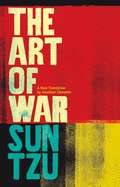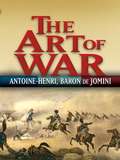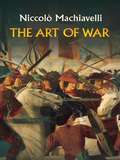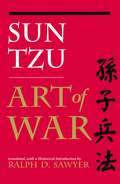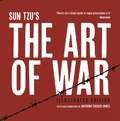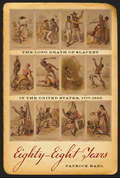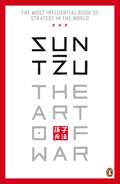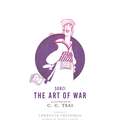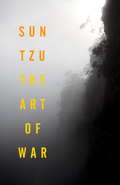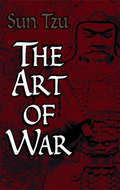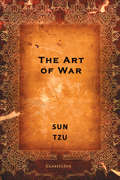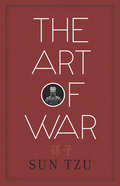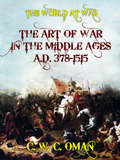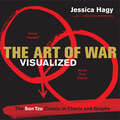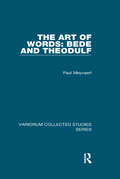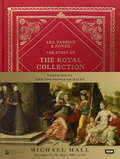- Table View
- List View
The Art of War: A New Translation (Penguin Modern Classics Ser. #909)
by Jonathan ClementsA new translation for the 21st century.The Art of War by Sun Tzu is one of the most influential political and business books of our era. This gateway edition for the 21st century reader rediscovers the essential clarity of the ancient masterpiece, cited by generals from a dozen Chinese dynasties, international business leaders, and modern military field manuals.This edition also contains a full commentary on Sun Tzu, the man and his ideas, contemporary of Confucius and Buddha; and a critical guide to further reading. This is the perfect introduction to one of the world's best-known classics.
The Art of War
by W. P. Craighill Antoine-Henri Jomini G. H. MendellAn eyewitness to most of the important battles of the Napoleonic Wars, Baron Antoine Henri de Jomini served with both the French and the Anglo-Allied armies. His firsthand accounts of the conflicts are the most authoritative ever written, hailed by experts as both accurate and insightful. It endures as the definitive work on strategy and tactics and as a fundamental source of modern military thought. In fact, generals on both sides of the American Civil War were well schooled in The Art of War. Jomini approaches warfare from several directions, including strategy, tactics, logistics, engineering, and diplomacy. He examines each in turn, and he offers an analysis of strategic problems posed by a variety of theaters and terrains, the tactics of attack and defense, surprise maneuvers, special operations, the importance of reconnaissance, and the deployment of forces.Few can match the breadth of advice offered by the man who was critical to the success of both Napoleon and Czar Alexander I. Unsurpassed in its influence on military thinking, doctrine, and vocabulary, Jomini's classic remains both a historic and practical guide to students of warfare.
Art of War
by Niccolò MachiavelliNiccolò Machiavelli's Art of War is one of the world's great classics of military and political theory. Praised by the finest military minds in history and said to have influenced no lesser lights than Frederick the Great and Napoleon, the Art of War is essential reading for anyone who wants to understand the history and theory of war in the West—and for readers of The Prince and Discourse on Livy who seek to explore more fully the connection between war and politics in Machiavelli's thought. Machiavelli scholar Christopher Lynch offers a sensitive and entirely new translation of the Art of War, faithful to the original but rendered in modern, idiomatic English. Lynch's fluid translation helps readers appreciate anew Machiavelli's brilliant treatments of the relationships between war and politics, civilians and the military, and technology and tactics. Clearly laying out the fundamentals of military organization and strategy, Machiavelli marshals a veritable armory of precepts, prescriptions, and examples about such topics as how to motivate your soldiers and demoralize the enemy's, avoid ambushes, and gain the tactical and strategic advantage in countless circumstances. To help readers better appreciate the Art of War, Lynch provides an insightful introduction that covers its historical and political context, sources, influence, and contemporary relevance. He also includes a substantial interpretive essay discussing the military, political, and philosophical aspects of the work, as well as maps, an index of names, and a glossary.
The Art of War
by Henry Neville Niccolò MachiavelliFlorentine statesman, writer, and political theorist, Niccolò Machiavelli (1469-1527) considered The Art of War his most important work. Five centuries later, after serving as a guide to Frederick the Great, Napoleon, and countless other military leaders, it remains an authoritative treatise on the fundamentals of warfare.Best known as the political theorist who wrote The Prince, Machiavelli used this book to advocate strategies for Italy's increased military prowess and political strength. Machiavelli was the first to propose a global context for the functional unity of war and politics, with the former serving as an instrument of the latter. Written in the form of dialogues, this 1520 work represents a humanistic treatment rather than a textbook approach. It clearly states and discusses the fundamentals of military organization and strategy: handling recruitment and weapons, motivating troops, demoralizing enemies, and achieving tactical and strategic advantages. Essential to the education of students of military history, strategy, and theory, The Art of War continues to inspire readers.
The Art of War: Sun Tzu's Classic In Plain English With Sun Pin's The Art Of Warfare (Penguin Modern Classics Ser. #909)
by Tzu SunThe definitive translation of Sun-tzu's timeless classic of military strategy, Art of WarArt of War is almost certainly the most famous study of strategy ever written and has had an extraordinary influence on the history of warfare. The principles Sun-tzu expounded were utilized brilliantly by such great Asian war leaders as Mao Tse-tung, Giap, and Yamamoto. First translated two hundred years ago by a French missionary, Sun-tzu's Art of War has been credited with influencing Napoleon, the German General Staff, and even the planning for Desert Storm. Many Japanese companies make this book required reading for their key executives. And increasingly, Western businesspeople and others are turning to the Art of War for inspiration and advice on how to succeed in competitive situations of all kinds. Unlike most editions of Sun-tzu currently available (many simply retreads of older, flawed translations), this superb translation makes use of the best available classical Chinese manuscripts, including the ancient "tomb text" version discovered by archaeologists at Linyi, China. Ralph Sawyer, an outstanding Western scholar of ancient Chinese warfare and a successful businessman in his own right, places this classic work of strategy in its proper historical context. Sawyer supplies a portrait of Sun-tzu's era and outlines several battles of the period that may have either influenced Sun-tzu or been conducted by him. While appreciative of the philosophical richness of the Art of War, this edition stresses Sun-tzu's practical origins and presents a translation that is both accurate and accessible.
The Art of War: Illustrated Edition
by Tzu Sun Anthony Tucker-JonesA new illustrated edition of Sun Tzu's classic ancient Chinese meditation on military strategy and human psychology, with a new commentary that highlight its continued relevance for modern readers.Poetic and immensely readable, The Art of War was written 2,500 years ago and the military manual is still relevant today. A fascinating historical document that sheds light on ancient warfare, it is also a profound meditation on human psychology, interrogating the subjects of leadership, self-discipline and self-awareness.This new edition of the classic work is specially designed for modern readers. It includes an insightful introduction to the historical and philosophical context, and is accompanied by explanation and analysis of how Sun Tzu's lessons have been applied in some of the world's most famous battles. Renowned strategists from Field Marshal Montgomery to General Schwarzkopf have cited the book as an inspiration.The ancient text, attributed to Sun Tzu, is divided into 13 chapters that provide a logical and strategic approach to conflict and competition. Each focuses on a different aspect of warfare, including the importance of planning, managing your forces, decision-making, knowing your strengths and weaknesses, the art of deception and understanding the power of information.This edition, featuring more than 28 evocative photographs, offers a new perspective on a classic work and enables new generations to discover The Art of War and find new applications for the wisdom of Sun Tzu.
The Art of War: Illustrated Edition (Bloomsbury Revelations Ser. #909)
by Tzu Sun Anthony Tucker-JonesA new illustrated edition of Sun Tzu's classic ancient Chinese meditation on military strategy and human psychology, with a new commentary that highlight its continued relevance for modern readers.Poetic and immensely readable, The Art of War was written 2,500 years ago and the military manual is still relevant today. A fascinating historical document that sheds light on ancient warfare, it is also a profound meditation on human psychology, interrogating the subjects of leadership, self-discipline and self-awareness.This new edition of the classic work is specially designed for modern readers. It includes an insightful introduction to the historical and philosophical context, and is accompanied by explanation and analysis of how Sun Tzu's lessons have been applied in some of the world's most famous battles. Renowned strategists from Field Marshal Montgomery to General Schwarzkopf have cited the book as an inspiration.The ancient text, attributed to Sun Tzu, is divided into 13 chapters that provide a logical and strategic approach to conflict and competition. Each focuses on a different aspect of warfare, including the importance of planning, managing your forces, decision-making, knowing your strengths and weaknesses, the art of deception and understanding the power of information.This edition, featuring more than 28 evocative photographs, offers a new perspective on a classic work and enables new generations to discover The Art of War and find new applications for the wisdom of Sun Tzu.
The Art of War: The Essential Translation Of The Classic Book Of Life (Penguin Modern Classics Series #909)
by Sun-Tzu John MinfordThroughout history, some books have changed the world. They have transformed the way we see ourselves - and each other. They have inspired debate, dissent, war and revolution. They have enlightened, outraged, provoked and comforted. They have enriched lives - and destroyed them. Now Penguin brings you the works of the great thinkers, pioneers, radicals and visionaries whose ideas shook civilization and helped make us who we are.Offering ancient wisdom on how to use skill, cunning, tactics and discipline to outwit your opponent, this bestselling 2000-year-old military manual is still worshipped by soldiers on the battlefield and managers in the boardroom as the ultimate guide to winning.
The Art of War: An Illustrated Edition (The Illustrated Library of Chinese Classics)
by Sunzi C. C. Tsai Brian Bruya Lawrence FreedmanA delightfully illustrated version of Sunzi’s classic The Art of War by bestselling cartoonist C. C. TsaiC. C. Tsai is one of Asia's most popular cartoonists, and his editions of the Chinese classics have sold more than 40 million copies in over twenty languages. This volume presents Tsai's delightful graphic adaptation of Sunzi's Art of War, the most profound book on warfare and strategy ever written--a work that continues to be read as a handbook for success not just by military commanders but also by leaders in politics, business, and many other fields.Conceived by a Chinese warrior-philosopher some 2,500 years ago, The Art of War speaks to those aspiring to rise through the ranks and help build successful countries. How can that goal best be achieved, and what is the role of warfare, if any, in the process? What are the powers and limits of the general in command? How can you win without going to war? Sunzi's answers to these and other questions are brought to life as never before by Tsai's brilliant cartoons, which show Sunzi fighting on dangerous ground, launching a surprise attack, spying on his enemies, and much more.A marvelously rich introduction to a timeless classic, this book also features a foreword by Lawrence Freedman, one of the world's leading authorities on military strategy, which illuminates how The Art of War has influenced Western strategic thought. In addition, Sunzi's original Chinese text is artfully presented in narrow sidebars on each page, enriching the books for readers and students of Chinese without distracting from the self-contained English-language cartoons. The text is skillfully translated by Brian Bruya, who also provides an introduction.
The Art of War
by Sun TzuA definitive treatise on military tactics that continues to be relevant today. The Art of War has been translated into several languages, and continues to be referenced as a source of wisdom by high-ranking military officers around the world, as well as those in business and corporate environments. Many military organizations and businesses have made it required reading. The Giles translation included here is the original English translation, complete with thorough annotations. Penguin Random House Canada is proud to bring you classic works of literature in e-book form, with the highest quality production values. Find more today and rediscover books you never knew you loved.
The Art of War
by Sun TzuPreserved in China for more than 2,000 years before it was brought to the West by the French, this compact little book is widely regarded as the oldest military treatise in the world. Rumored to have been used by Napoleon in his campaigns to conquer Europe, it today retains much of its original merit. American officers read it closely during World War II. The Japanese army studied the work for decades, and many 20th-century Chinese officers are said to have known the book by heart. More recently, it has also been viewed as a valuable guide to competing successfully in business.Stressing the importance of attacking your enemy when he is unprepared and scheming to discover his plans, the author advises avoiding the strong and striking at the weak, and using spies for every kind of business. Principles of strategy, tactics, maneuvering, and communications, the treatment of soldiers, the importance of strong troops and well-trained officers, and the administration of rewards and punishments all have a modern ring to them.A valuable guide to the conduct of war, this classic of military strategy is indispensable to military personnel, history enthusiasts, and anyone intrigued by competition and rivalry.
The Art of War: The Essential Translation Of The Classic Book Of Life (Penguin Modern Classics Series #909)
by Sun TzuAn ancient Chinese military text, The Art of War is a strategic and intellectual examination of the different aspects of warfare, and has served as a foundation of military doctrine from ancient to modern times. With discussions ranging from the use of force to civilian casualties, The Art of War continues to be a relevant and insightful treatise on military engagement.Be it mystery, romance, drama, comedy, politics, or history, great literature stands the test of time. ClassicJoe proudly brings literary classics to today's digital readers, connecting those who love to read with authors whose work continues to get people talking. Look for other fiction and non-fiction classics from ClassicJoe.
The Art of War (Penguin Modern Classics #909)
by Sun TzuRegarded as the world's oldest military treatise, this compact volume has instructed officers and tacticians for more than 2,000 years. From its origins in China, The Art of War traveled the world to inform the strategies of Napoleon and World War II generals. More recently, it has taken on a new life as a guide to competing successfully in business, law, and sports.All of The Art of War's concepts retain their value to modern readers, from the prudence of circumventing a strong opponent and taking advantage of a weak one to the wisdom of preparedness and flexibility. Other topics include strategy, tactics, maneuvering, communications, the treatment of soldiers, and the worth of well-trained officers. History enthusiasts, business thought leaders, and anyone intrigued by competition and rivalry will appreciate this elegant edition of the classic work.
The Art of War in an Age of Peace: U.S. Grand Strategy and Resolute Restraint
by Michael O'HanlonAn informed modern plan for post-2020 American foreign policy that avoids the opposing dangers of retrenchment and overextension Russia and China are both believed to have “grand strategies”—detailed sets of national security goals backed by means, and plans, to pursue them. In the United States, policy makers have tried to articulate similar concepts but have failed to reach a widespread consensus since the Cold War ended. While the United States has been the world’s prominent superpower for over a generation, much American thinking has oscillated between the extremes of isolationist agendas versus interventionist and overly assertive ones. Drawing on historical precedents and weighing issues such as Russia’s resurgence, China’s great rise, North Korea’s nuclear machinations, and Middle East turmoil, Michael O’Hanlon presents a well†‘researched, ethically sound, and politically viable vision for American national security policy. He also proposes complementing the Pentagon’s set of “4+1” pre†‘existing threats with a new “4+1”: biological, nuclear, digital, climatic, and internal dangers.
The Art of War in the Middle Ages A.D. 378-1515: A. D. 378-1515 (classic Reprint) (The World At War)
by C. W. C. OmanThis history of medieval warfare, originally written in 1885 when its author later one of the great medievalists was still an undergraduate at Oxford, remains for students and general readers one of the best accounts of military art in the Middle Ages between Adrianople in 378 A.D. (the most fearful defeat suffered by a Roman army since Cannae in 216 B.C.) and Marignano (1515 A.D.), the last of the triumphs of the medieval horseman. (Goodreads)
The Art of War Visualized: The Sun Tzu Classic in Charts and Graphs
by Jessica HagyIt&’s the perfect meeting of minds. One, a general whose epigrammatic lessons on strategy offer timeless insight and wisdom. And the other, a visual thinker whose succinct diagrams and charts give readers a fresh way of looking at life&’s challenges and opportunities. A Bronze Age/Information Age marriage of Sun Tzu and Jessica Hagy, The Art of War Visualized is an inspired mash-up, a work that completely reenergizes the perennial bestseller and makes it accessible to a new generation of students, entrepreneurs, business leaders, artists, seekers, lovers of games and game theory, and anyone else who knows the value of seeking guidance for the future in the teachings of the past. It&’s as if Sun Tzu got a 21st-century do-over. Author and illustrator of How to Be Interesting, Jessica Hagy is a cutting-edge thinker whose language—comprising circles, arrows, and lines and the well-chosen word or two—makes her an ideal philosopher for our ever-more-visual culture. Her charts and diagrams are deceptively simple, often funny, and always thought-provoking. She knows how to communicate not only ideas but the complex process of thinking itself, complete with its twists and surprises. For The Art of War Visualized, she presents her vision in evocative ink-brush art and bold typography. The result is page after page in which each passage of the complete canonical text (in its best-known Lionel Giles translation) is visually interpreted in a singular diagram, chart, or other illustration—transforming, reenergizing, and making the classic dazzlingly accessible for a new generation of readers.
The Art of Words: Bede and Theodulf
by Paul MeyvaertMedieval art is wordy; inscriptions and poems, commentaries and chronicles accompany and adorn it. The Art of Words presents a series of detective stories by a renowned explorer of medieval philological evidence who here examines the thought and objects of the Venerable Bede and Theodulf of Orleans. What physical objects did Bede have in mind, for example, when writing about the paintings of his monastic churches? How did he conceive of the division of biblical books into chapters? Why was the famous Libri Carolini made for Charlemagne never published? Indeed what did it mean in the Middle Ages to publish something? Pursuing the story of Bede's calendar shows how Valentine's Day began with a reference to birds. To unravel the meaning of the image of Ezra in the Codex Amiatinus the author then demonstrates the importance of knowing the books that Bede knew and wrote. The final topic is the celebrated Apse mosaic of Germigny-des-Prés, how it was saved from destruction and how Theodulf's words explain what we see. Words matter and, in these studies Paul Meyvaert constantly delights the reader with careful excavations of that place in medieval art and thought where images and words connect and collide.
The Art of Words: Bede and Theodulf
by Paul MeyvaertMedieval art is wordy; inscriptions and poems, commentaries and chronicles accompany and adorn it. The Art of Words presents a series of detective stories by a renowned explorer of medieval philological evidence who here examines the thought and objects of the Venerable Bede and Theodulf of Orleans. What physical objects did Bede have in mind, for example, when writing about the paintings of his monastic churches? How did he conceive of the division of biblical books into chapters? Why was the famous Libri Carolini made for Charlemagne never published? Indeed what did it mean in the Middle Ages to publish something? Pursuing the story of Bede's calendar shows how Valentine's Day began with a reference to birds. To unravel the meaning of the image of Ezra in the Codex Amiatinus the author then demonstrates the importance of knowing the books that Bede knew and wrote. The final topic is the celebrated Apse mosaic of Germigny-des-Prés, how it was saved from destruction and how Theodulf's words explain what we see. Words matter and, in these studies Paul Meyvaert constantly delights the reader with careful excavations of that place in medieval art and thought where images and words connect and collide.
The Art of Writing for the Theatre: An Introduction to Script Analysis, Criticism, and Playwriting (Introductions to Theatre)
by Luke YankeeWriting for the theatre and about theatre requires a diverse set of skills, but whether you're studying theatre or developing your creative craft, this book covers everything you need to know. Filled with practical advice from an award-winning playwright, with a range of resources to guide you in the craft and business of theatre writing, The Art of Writing for the Theatre provides everything you need to write like a seasoned theatre professional, including:* how to analyze and break down a script, * how to write various types of plays, from short plays, plays for one person, to one act and full length dramas, * how to critique a play and a theatre production, * how to construct and craft essays, cover letters, theatrical resumes, applications, and * how to avoid common grammar and punctuation errors.This thorough introduction is supplemented with exercises and new interviews with a host of internationally acclaimed playwrights, lyricists, and critics, including Lyn Gardner, Kia Corthron, Ismail Khalidi, Marsha Norman, and David Zippel, among many others. Accompanying online resources include playwriting and script analysis worksheets and exercises, an example of a playwriting resume, and critical points to consider on playwriting, design, acting, directing and choreography.
The Art of Writing for the Theatre: An Introduction to Script Analysis, Criticism, and Playwriting (Introductions to Theatre)
by Luke YankeeWriting for the theatre and about theatre requires a diverse set of skills, but whether you're studying theatre or developing your creative craft, this book covers everything you need to know. Filled with practical advice from an award-winning playwright, with a range of resources to guide you in the craft and business of theatre writing, The Art of Writing for the Theatre provides everything you need to write like a seasoned theatre professional, including:* how to analyze and break down a script, * how to write various types of plays, from short plays, plays for one person, to one act and full length dramas, * how to critique a play and a theatre production, * how to construct and craft essays, cover letters, theatrical resumes, applications, and * how to avoid common grammar and punctuation errors.This thorough introduction is supplemented with exercises and new interviews with a host of internationally acclaimed playwrights, lyricists, and critics, including Lyn Gardner, Kia Corthron, Ismail Khalidi, Marsha Norman, and David Zippel, among many others. Accompanying online resources include playwriting and script analysis worksheets and exercises, an example of a playwriting resume, and critical points to consider on playwriting, design, acting, directing and choreography.
Art, Passion & Power: The Story of the Royal Collection
by Michael Hall H.R.H The Wales"Hall’s consummate history is not just the story of the evolution of one of the world’s great collections… The book is also a through-the-keyhole insight into the shifting tastes, good or bad, of 1,000 years of monarchs."- The TimesThe Royal Collection is the last great collection formed by the European monarchies to have survived into the twenty-first century. Containing over a million artworks and objects, it covers all aspects of the fine and decorative arts, from paintings by Rembrandt and Michelangelo to grand sculpture, Fabergé eggs and some of the most exquisite furniture ever made. The Royal Collection also offers a revealing insight into the history of the British monarchy from William the Conqueror to Queen Elizabeth II, recording the tastes and obsessions of kings and queens over the past 500 years. With unprecedented access to the royal residences of St James' Palace, Windsor Castle and Buckingham Palace, Art, Passion & Power traces the history of this national institution from the Middle Ages to the present day, exploring how royalty used the arts to strengthen their position as rulers by divine right and celebrating treasures from the Crown Jewels to the "Abraham" tapestries in Hampton Court Palace. Author Michael Hall examines the monarchy's response to changing attitudes to the arts and sciences during the Enlightenment and celebrates the British monarchy's role in the democratisation of art in the modern world. Packed with glimpses of rarely seen artworks, Art, Passion & Power is a visual treat for all art enthusiasts. Accompanying the BBC television series and a major exhibition at the Royal Academy, Art, Passion & Power is the definitive statement on the British monarchy's treasures of the art world.
Art Patronage and Conflicting Memories in Early Modern Iberia: The Marquises of Villena (Routledge Research in Art History)
by Maria Teresa Chicote PompaninThis volume investigates the mechanisms (artworks, treatises, and other forms of cultural patronage) that the Marquises of Villena and their opponents used to operate in the cultural battlefield of the time with the aim of understanding how their conflicting historical memories were constructed and manipulated. Concentrating on the late fifteenth and early sixteenth centuries, the book examines these two aristocrats and demonstrates that political tensions led not only to military conflicts during this period but also to conflicts fought on cultural grounds, through the promotion of artistic, religious, and literary programmes. Maria Teresa Chicote Pompanin investigates why the Marquises of Villena lost in both the military and cultural battlefields and explains how the negative historical memories forged by their opponents in the late fifteenth century managed to become the official historical truth that has remained unchallenged to this day. The book will be of interest to scholars working in art history, cultural history, medieval studies, Renaissance studies, Iberian studies, literary studies, and patronage studies.
Art Patronage and Conflicting Memories in Early Modern Iberia: The Marquises of Villena (Routledge Research in Art History)
by Maria Teresa Chicote PompaninThis volume investigates the mechanisms (artworks, treatises, and other forms of cultural patronage) that the Marquises of Villena and their opponents used to operate in the cultural battlefield of the time with the aim of understanding how their conflicting historical memories were constructed and manipulated. Concentrating on the late fifteenth and early sixteenth centuries, the book examines these two aristocrats and demonstrates that political tensions led not only to military conflicts during this period but also to conflicts fought on cultural grounds, through the promotion of artistic, religious, and literary programmes. Maria Teresa Chicote Pompanin investigates why the Marquises of Villena lost in both the military and cultural battlefields and explains how the negative historical memories forged by their opponents in the late fifteenth century managed to become the official historical truth that has remained unchallenged to this day. The book will be of interest to scholars working in art history, cultural history, medieval studies, Renaissance studies, Iberian studies, literary studies, and patronage studies.
Art, Patronage, and Nepotism in Early Modern Rome (Visual Culture in Early Modernity)
by Karen J. LloydDrawing on rich archival research and focusing on works by leading artists including Guido Reni and Gian Lorenzo Bernini, Karen J. Lloyd demonstrates that cardinal nephews in seventeenth-century Rome – those nephews who were raised to the cardinalate as princes of the Church – used the arts to cultivate more than splendid social status. Through politically savvy frescos and emotionally evocative displays of paintings, sculptures, and curiosities, cardinal nephews aimed to define nepotism as good Catholic rule. Their commissions took advantage of their unique position close to the pope, embedding the defense of their role into the physical fabric of authority, from the storied vaults of the Vatican Palace to the sensuous garden villas that fused business and pleasure in the Eternal City. This book uncovers how cardinal nephews crafted a seductively potent dialogue on the nature of power, fuelling the development of innovative visual forms that championed themselves as the indispensable heart of papal politics. The book will be of interest to scholars working in art history, early modern studies, religious history, and political history.
Art, Patronage, and Nepotism in Early Modern Rome (Visual Culture in Early Modernity)
by Karen J. LloydDrawing on rich archival research and focusing on works by leading artists including Guido Reni and Gian Lorenzo Bernini, Karen J. Lloyd demonstrates that cardinal nephews in seventeenth-century Rome – those nephews who were raised to the cardinalate as princes of the Church – used the arts to cultivate more than splendid social status. Through politically savvy frescos and emotionally evocative displays of paintings, sculptures, and curiosities, cardinal nephews aimed to define nepotism as good Catholic rule. Their commissions took advantage of their unique position close to the pope, embedding the defense of their role into the physical fabric of authority, from the storied vaults of the Vatican Palace to the sensuous garden villas that fused business and pleasure in the Eternal City. This book uncovers how cardinal nephews crafted a seductively potent dialogue on the nature of power, fuelling the development of innovative visual forms that championed themselves as the indispensable heart of papal politics. The book will be of interest to scholars working in art history, early modern studies, religious history, and political history.
